Abstract
OBJECTIVES: This study examined the relationship between housing conditions, educational level, occupational factors, and serologically diagnosed acute and chronic Helicobacter pylori infection. METHODS: Immunoglobulin G and immunoglobulin M serum antibodies against H. pylori were measured in 3589 Danish adults who participated in a population study. RESULTS: Low socioeconomic status (odds ratio [OR] = 2.2, 95% confidence interval [CI] = 1.7, 3.0), short duration of schooling (OR = 2.0, 95% CI = 1.3, 2.5), lack of training/education (OR = 1.4, 95% CI = 1.2, 1.7]), unskilled work (OR = 1.7, 95% CI = 1.2, 2.5), and high work-related energy expenditure (OR = 1.4, 95% CI = 1.1, 1.9) increased the likelihood of chronic H. pylori infection. Infection was frequent in people who had lived abroad. Increased levels solely of immunoglobulin M antibodies were found more often in people who were divorced (OR = 2.3, 95% CI = 1.2, 4.4) or unmarried (OR = 2.0, 95% CI = 1.1, 3.8) or who worked long hours (OR = 2.0, 95% CI = 1.1, 4.0). CONCLUSIONS: Educational and occupational factors relate to the likelihood of chronic H. pylori infection in adults. The rate of acute infection is high in single individuals.
Full text
PDF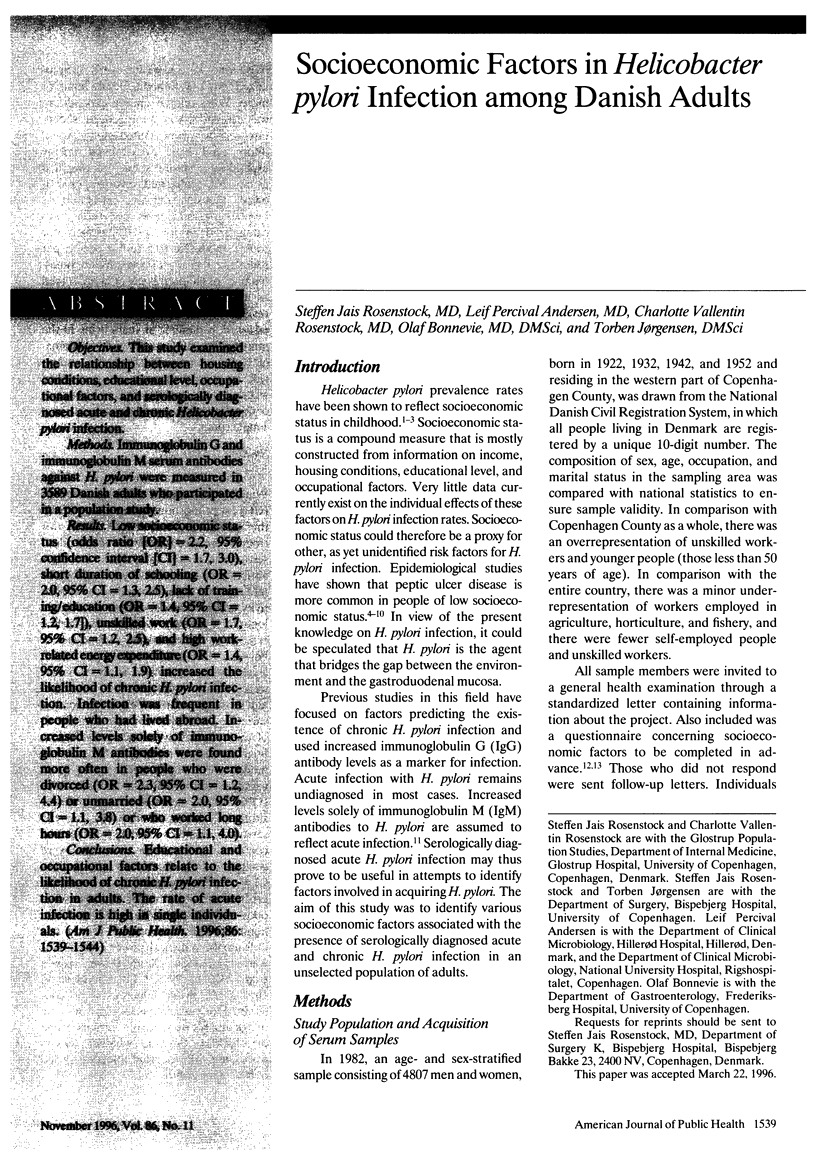
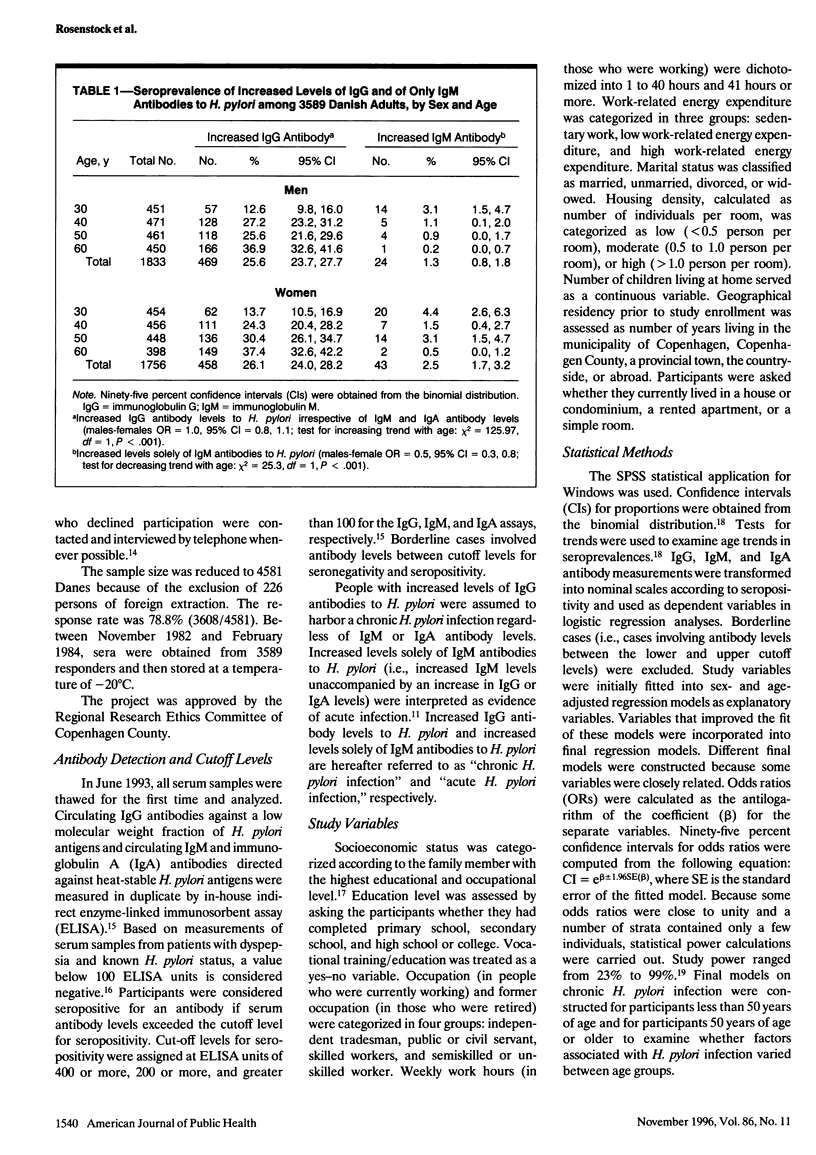
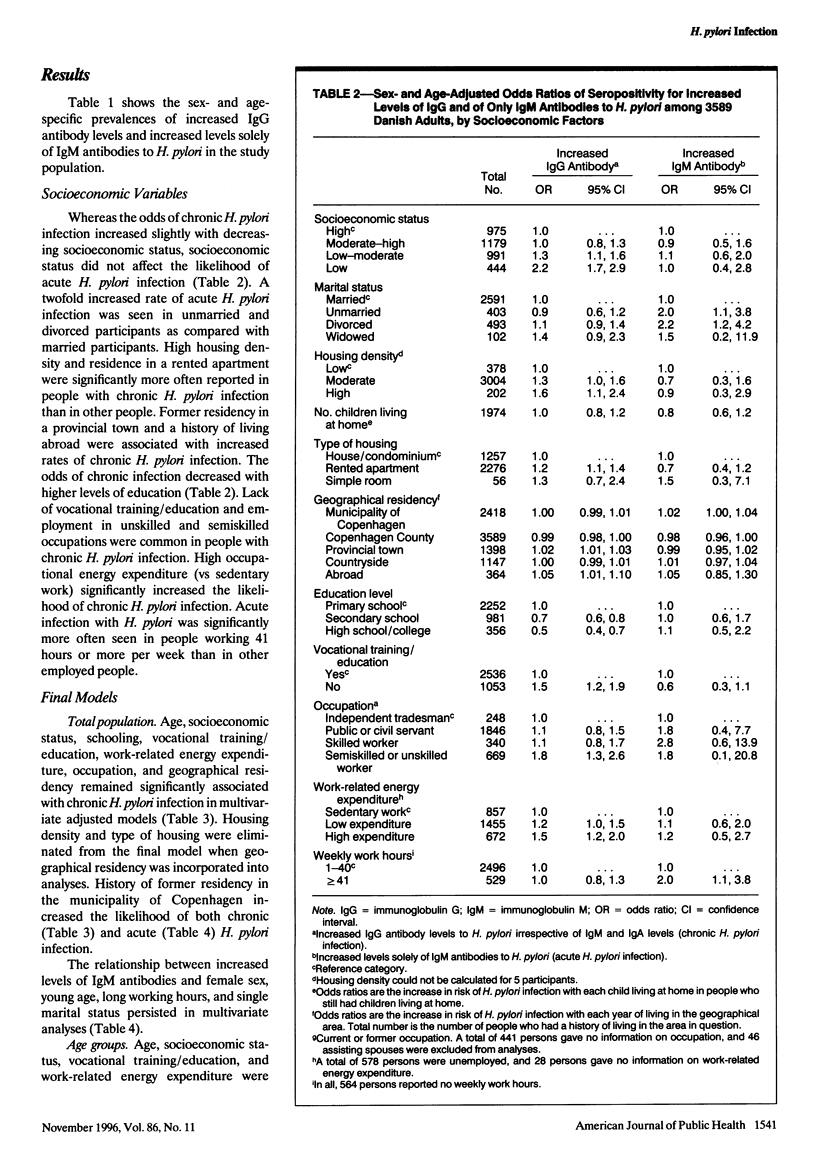
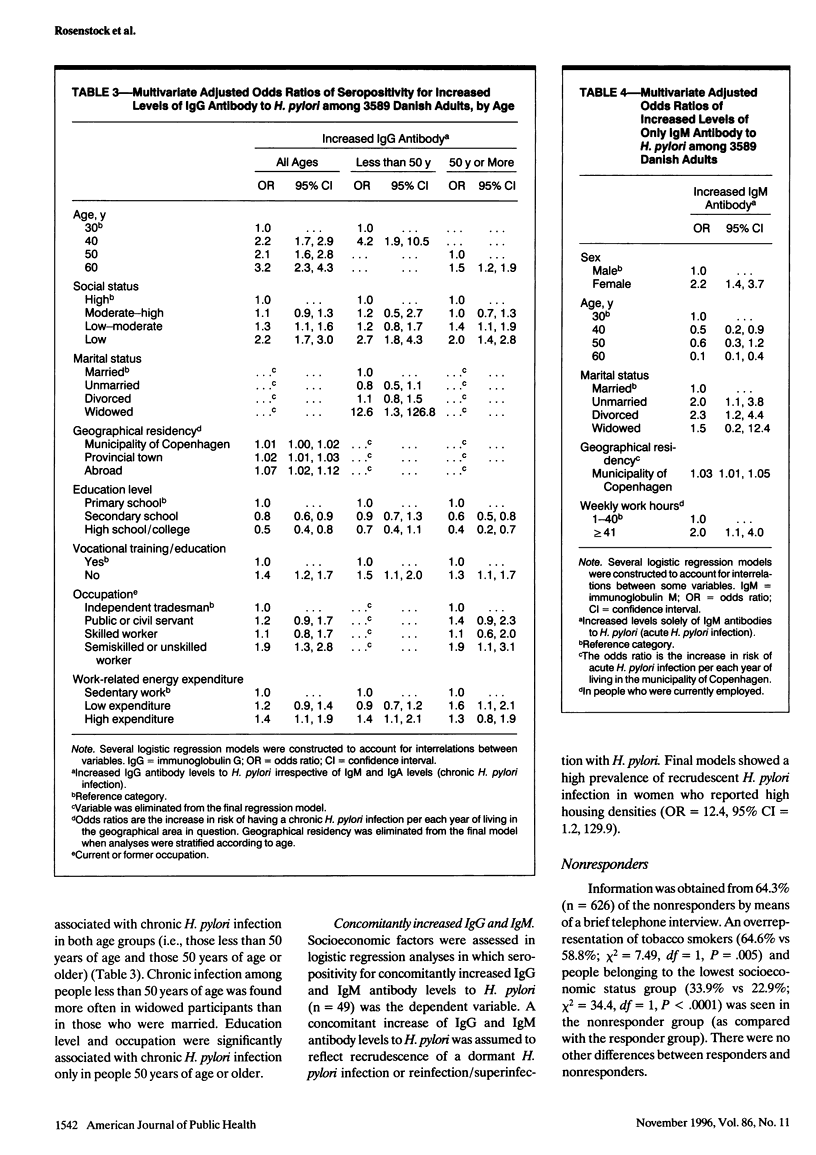
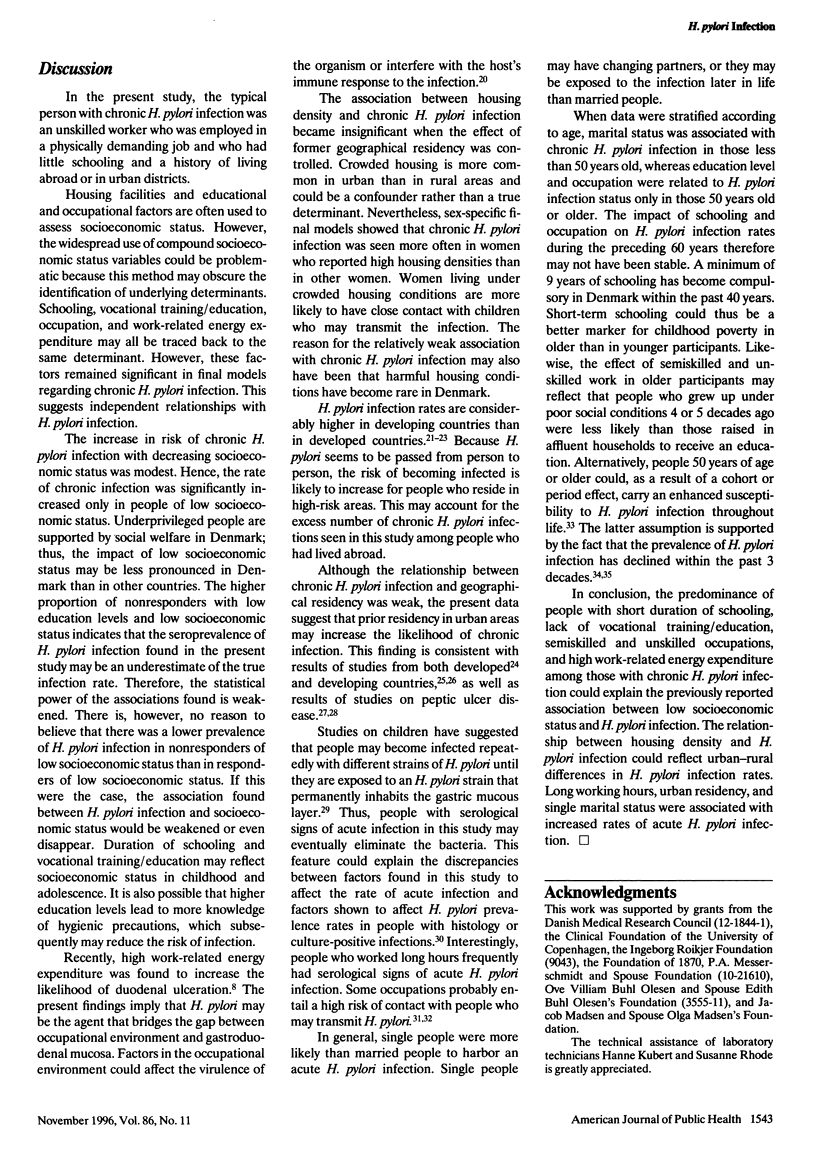
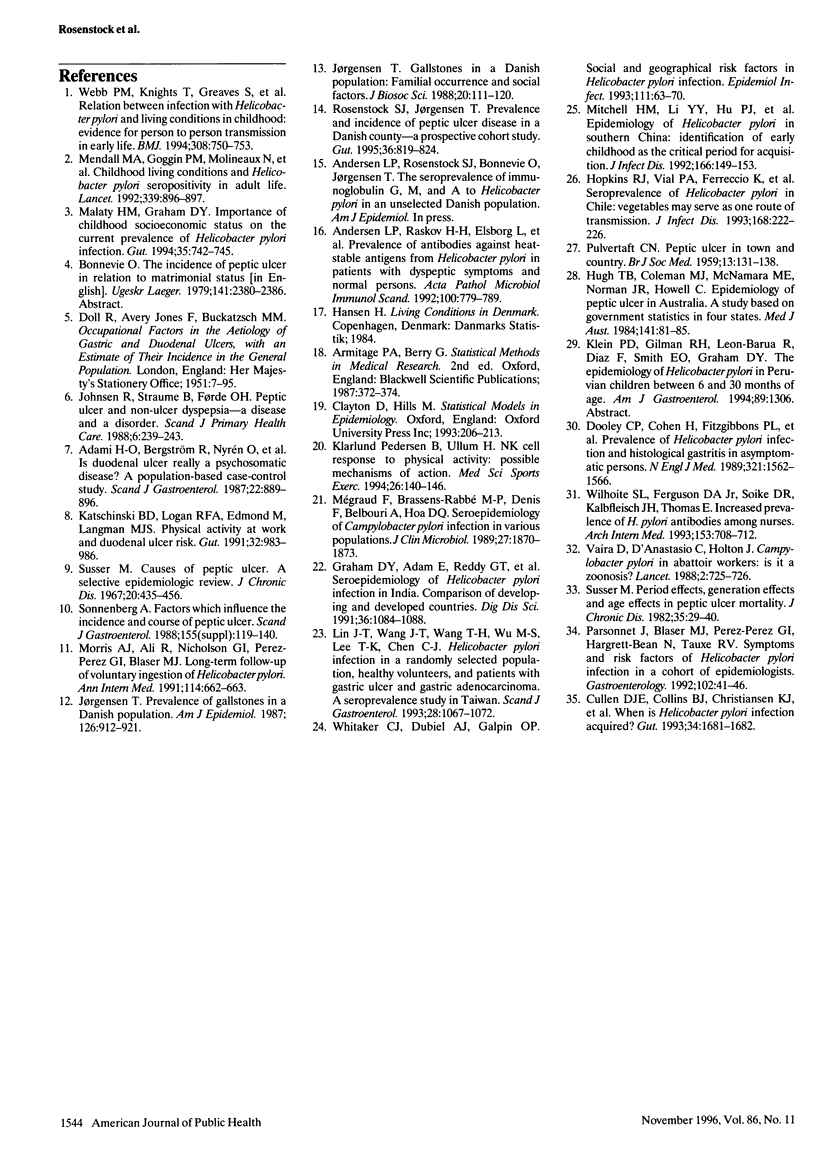
Selected References
These references are in PubMed. This may not be the complete list of references from this article.
- Adami H. O., Bergström R., Nyrén O., Forhaug K., Gustavsson S., Löf L., Nyberg A. Is duodenal ulcer really a psychosomatic disease? A population-based case-control study. Scand J Gastroenterol. 1987 Sep;22(7):889–896. doi: 10.3109/00365528708991931. [DOI] [PubMed] [Google Scholar]
- Andersen L. P., Raskov H., Elsborg L., Holck S., Justesen T., Fischer Hansen B., Møller Nielsen C., Gaarslev K. Prevalence of antibodies against heat-stable antigens from Helicobacter pylori in patients with dyspeptic symptoms and normal persons. APMIS. 1992 Sep;100(9):779–789. [PubMed] [Google Scholar]
- Bonnevie O. Ulcussygdommens relation til sociale og arbejdsmaessige forhold. En epidemiologisk undersøgelse. Ugeskr Laeger. 1979 Aug 27;141(35):2380–2387. [PubMed] [Google Scholar]
- Cullen D. J., Collins B. J., Christiansen K. J., Epis J., Warren J. R., Surveyor I., Cullen K. J. When is Helicobacter pylori infection acquired? Gut. 1993 Dec;34(12):1681–1682. doi: 10.1136/gut.34.12.1681. [DOI] [PMC free article] [PubMed] [Google Scholar]
- Dooley C. P., Cohen H., Fitzgibbons P. L., Bauer M., Appleman M. D., Perez-Perez G. I., Blaser M. J. Prevalence of Helicobacter pylori infection and histologic gastritis in asymptomatic persons. N Engl J Med. 1989 Dec 7;321(23):1562–1566. doi: 10.1056/NEJM198912073212302. [DOI] [PubMed] [Google Scholar]
- Graham D. Y., Adam E., Reddy G. T., Agarwal J. P., Agarwal R., Evans D. J., Jr, Malaty H. M., Evans D. G. Seroepidemiology of Helicobacter pylori infection in India. Comparison of developing and developed countries. Dig Dis Sci. 1991 Aug;36(8):1084–1088. doi: 10.1007/BF01297451. [DOI] [PubMed] [Google Scholar]
- Hopkins R. J., Vial P. A., Ferreccio C., Ovalle J., Prado P., Sotomayor V., Russell R. G., Wasserman S. S., Morris J. G., Jr Seroprevalence of Helicobacter pylori in Chile: vegetables may serve as one route of transmission. J Infect Dis. 1993 Jul;168(1):222–226. doi: 10.1093/infdis/168.1.222. [DOI] [PubMed] [Google Scholar]
- Hugh T. B., Coleman M. J., McNamara M. E., Norman J. R., Howell C. Epidemiology of peptic ulcer in Australia. A study based on government statistics in four states. Med J Aust. 1984 Jul 21;141(2):81–85. [PubMed] [Google Scholar]
- Johnsen R., Straume B., Førde O. H. Peptic ulcer and non-ulcer dyspepsia--a disease and a disorder. Scand J Prim Health Care. 1988 Nov;6(4):239–243. doi: 10.3109/02813438809009324. [DOI] [PubMed] [Google Scholar]
- Jørgensen T. Gallstones in a Danish population: familial occurrence and social factors. J Biosoc Sci. 1988 Jan;20(1):111–120. doi: 10.1017/s0021932000017302. [DOI] [PubMed] [Google Scholar]
- Katschinski B. D., Logan R. F., Edmond M., Langman M. J. Physical activity at work and duodenal ulcer risk. Gut. 1991 Sep;32(9):983–986. doi: 10.1136/gut.32.9.983. [DOI] [PMC free article] [PubMed] [Google Scholar]
- Lin J. T., Wang J. T., Wang T. H., Wu M. S., Lee T. K., Chen C. J. Helicobacter pylori infection in a randomly selected population, healthy volunteers, and patients with gastric ulcer and gastric adenocarcinoma. A seroprevalence study in Taiwan. Scand J Gastroenterol. 1993 Dec;28(12):1067–1072. doi: 10.3109/00365529309098311. [DOI] [PubMed] [Google Scholar]
- Malaty H. M., Graham D. Y. Importance of childhood socioeconomic status on the current prevalence of Helicobacter pylori infection. Gut. 1994 Jun;35(6):742–745. doi: 10.1136/gut.35.6.742. [DOI] [PMC free article] [PubMed] [Google Scholar]
- Mendall M. A., Goggin P. M., Molineaux N., Levy J., Toosy T., Strachan D., Northfield T. C. Childhood living conditions and Helicobacter pylori seropositivity in adult life. Lancet. 1992 Apr 11;339(8798):896–897. doi: 10.1016/0140-6736(92)90931-r. [DOI] [PubMed] [Google Scholar]
- Mitchell H. M., Li Y. Y., Hu P. J., Liu Q., Chen M., Du G. G., Wang Z. J., Lee A., Hazell S. L. Epidemiology of Helicobacter pylori in southern China: identification of early childhood as the critical period for acquisition. J Infect Dis. 1992 Jul;166(1):149–153. doi: 10.1093/infdis/166.1.149. [DOI] [PubMed] [Google Scholar]
- Morris A. J., Ali M. R., Nicholson G. I., Perez-Perez G. I., Blaser M. J. Long-term follow-up of voluntary ingestion of Helicobacter pylori. Ann Intern Med. 1991 Apr 15;114(8):662–663. doi: 10.7326/0003-4819-114-8-662. [DOI] [PubMed] [Google Scholar]
- Mégraud F., Brassens-Rabbé M. P., Denis F., Belbouri A., Hoa D. Q. Seroepidemiology of Campylobacter pylori infection in various populations. J Clin Microbiol. 1989 Aug;27(8):1870–1873. doi: 10.1128/jcm.27.8.1870-1873.1989. [DOI] [PMC free article] [PubMed] [Google Scholar]
- PULVERTAFT C. N. Peptic ulcer in twon and country. Br J Prev Soc Med. 1959 Jul;13:131–138. doi: 10.1136/jech.13.3.131. [DOI] [PMC free article] [PubMed] [Google Scholar]
- Parsonnet J., Blaser M. J., Perez-Perez G. I., Hargrett-Bean N., Tauxe R. V. Symptoms and risk factors of Helicobacter pylori infection in a cohort of epidemiologists. Gastroenterology. 1992 Jan;102(1):41–46. doi: 10.1016/0016-5085(92)91782-y. [DOI] [PubMed] [Google Scholar]
- Pedersen B. K., Ullum H. NK cell response to physical activity: possible mechanisms of action. Med Sci Sports Exerc. 1994 Feb;26(2):140–146. doi: 10.1249/00005768-199402000-00003. [DOI] [PubMed] [Google Scholar]
- Rosenstock S. J., Jørgensen T. Prevalence and incidence of peptic ulcer disease in a Danish County--a prospective cohort study. Gut. 1995 Jun;36(6):819–824. doi: 10.1136/gut.36.6.819. [DOI] [PMC free article] [PubMed] [Google Scholar]
- Sonnenberg A. Factors which influence the incidence and course of peptic ulcer. Scand J Gastroenterol Suppl. 1988;155:119–140. doi: 10.3109/00365528809096294. [DOI] [PubMed] [Google Scholar]
- Susser M. Period effects, generation effects and age effects in peptic ulcer mortality. J Chronic Dis. 1982;35(1):29–40. doi: 10.1016/0021-9681(82)90027-3. [DOI] [PubMed] [Google Scholar]
- Usser M. Causes of peptic ulcer. A selective epidemiologic review. J Chronic Dis. 1967 Jun;20(6):435–456. doi: 10.1016/0021-9681(67)90015-x. [DOI] [PubMed] [Google Scholar]
- Vaira D., D'Anastasio C., Holton J., Dowsett J. F., Londei M., Bertoni F., Beltrandi E., Grauenfels P., Salmon P. R., Gandolfi L. Campylobacter pylori in abattoir workers: is it a zoonosis? Lancet. 1988 Sep 24;2(8613):725–726. doi: 10.1016/s0140-6736(88)90196-1. [DOI] [PubMed] [Google Scholar]
- Webb P. M., Knight T., Greaves S., Wilson A., Newell D. G., Elder J., Forman D. Relation between infection with Helicobacter pylori and living conditions in childhood: evidence for person to person transmission in early life. BMJ. 1994 Mar 19;308(6931):750–753. doi: 10.1136/bmj.308.6931.750. [DOI] [PMC free article] [PubMed] [Google Scholar]
- Whitaker C. J., Dubiel A. J., Galpin O. P. Social and geographical risk factors in Helicobacter pylori infection. Epidemiol Infect. 1993 Aug;111(1):63–70. doi: 10.1017/s0950268800056685. [DOI] [PMC free article] [PubMed] [Google Scholar]
- Wilhoite S. L., Ferguson D. A., Jr, Soike D. R., Kalbfleisch J. H., Thomas E. Increased prevalence of Helicobacter pylori antibodies among nurses. Arch Intern Med. 1993 Mar 22;153(6):708–712. [PubMed] [Google Scholar]


